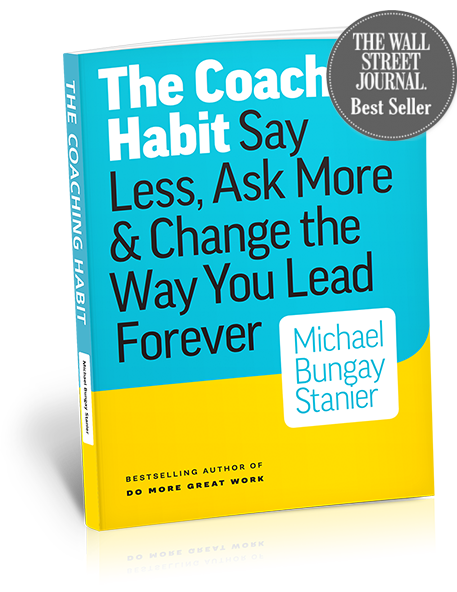One of my goals for the year is to get better at asking questions. To do that, I needed some help and a little inspiration. I found both in Michael Bungay Stanier’s book, The Coaching Habit: Say Less, Ask More, and Change the Way You Lead Forever.
The Coaching Habit: An Overview
The Coaching Habit is a quick read meant for managers who coach people every day. Most people can finish the book in a couple of hours.
At its core, the book is seven questions and a few question-asking tips all wrapped into a framework for changing habits. Stanier begins with an overview of how to create or change a habit. A lot of his research is drawn from books like Charles Duhigg’s The Power of Habit and other classics.
After that, he launches into seven questions to ask your team, starting with “What’s on your mind?” and ending with “What was most useful for you?” The questions are meant to draw out options; challenging your people to think for themselves and challenging you, their manager, to stop jumping in and solving problems too quickly. In fact, Stanier argues that you’re probably wasting a lot of time solving the wrong problems and getting in the way of your employees’ growth.
You’re probably wasting a lot of time solving the wrong problems and getting in the way of your employees’ growth.
Each question’s chapter includes a couple of workbook pages for you to plan out how you’ll change your habits to ensure you’re using these questions effectively.
Could the book have been a nice, long blog post? Probably! But Stanier includes enough practical information, great questions, and references to good books that it’s worth your time to read.
Main Takeaways
Stanier suggests that asking great questions leads to better people and less work for you as a manager. OK, I’m listening.
But you can’t just launch into asking more questions because we’re all just creatures of habit. We’ll likely set a goal, ask great questions for a day, and then go back to what we were doing. We need to very thoughtfully plan out how we’ll incorporate Stanier’s seven questions into our daily conversations.
Forming Habits
To change a habit, you must identify the trigger that launches you into something you do – some sort of “routine” as Duhigg called it. The trigger could be location, time, emotional state, other people, or preceding action. For instance, one of your triggers might be finishing up a meal (preceding action) at home (location) with your family (other people). It triggers you to think about having dessert. Eating dessert is the routine and the reward (the reason why you keep doing it) is because it tastes good.
All questions and any coaching tips aside, understanding the process of habit-formation alone was a pretty great take-away from this book, in and of itself.
The Questions
The seven questions themselves are great questions! I’ve used the first one: “What’s on your mind?” for years and it does a good job of kick-starting a conversation.
The final question, “What was most useful for you?” is what I call a retrospective question. It turns out, we never truly learn something until we review it in our heads. This question, used at the end of a conversation, encourages direct reports to recall what they learned and review it in a way that will make it stick.
The other question that I really liked was, “What’s the real challenge here for you?” When directs are rattling on about 1000 different problems, that question helps them focus and figure out for themselves what they should be doing to tackle these problems.
Tips & Tricks
Stanier includes a lot of question-asking tips along the way too. For example:
- Only ask one question at a time
- Don’t offer advice disguised as a question
- Try not to ask questions that start with why (they seem accusatory)
- Don’t fill the silence and actually listen to answers
What Will I Work on First?
As the book suggests, I’ve got to commit to making small changes in order to form new coaching habits. My current goal is to follow-up the one-on-one opener (“What’s on your mind?”) with a follow-on question, “And what else?”. This should draw out more topics for the conversation and keeps me from jumping in right away with solutions.
Conclusion
Read The Coaching Habit. The questions alone are worth the short time it’ll take you to read. The habit-forming guidance is sound. It’s a good, little all-around book.
